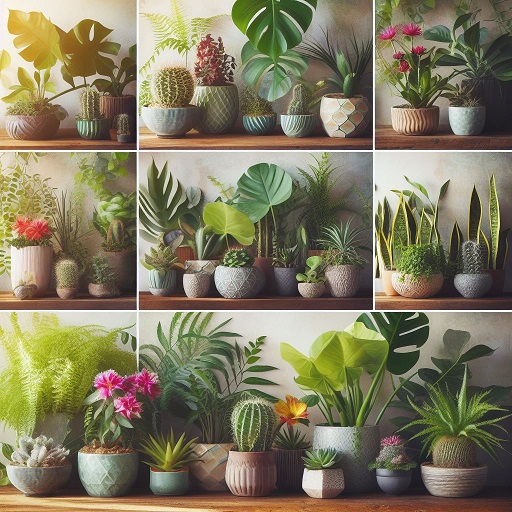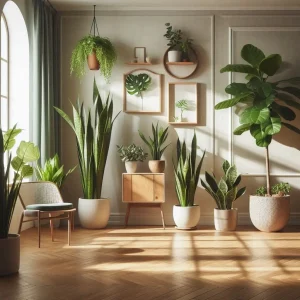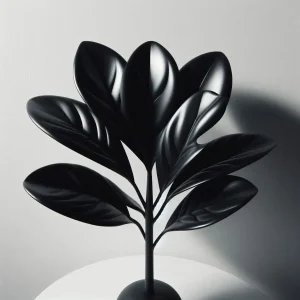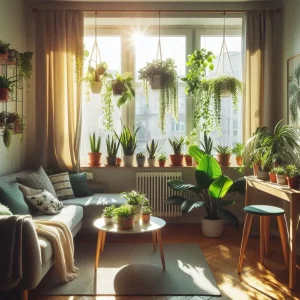Indoor plants not only beautify our living spaces but also contribute to a healthier, more vibrant environment. Among the various options available, low maintenance plants are particularly popular for their ability to thrive with minimal care. In this article, we’ll introduce you to some of the best low maintenance indoor plants, each with its unique characteristics and care requirements. Whether you’re a seasoned plant enthusiast or just starting to cultivate your indoor garden, these plants are sure to add a touch of nature to your home or office effortlessly. Let’s explore these green companions and learn how to nurture them for long-lasting beauty and vitality.
| Plant Name | Light | Watering | Temperature | Humidity | Soil |
|---|---|---|---|---|---|
| String of Hearts | Bright, indirect light | Allow soil to dry out between waterings | 60-85°F (15-29°C) | Average | Well-draining |
| Snake Plant | Low to bright indirect light | Allow soil to dry out between waterings | 60-85°F (15-29°C) | Low | Well-draining |
| ZZ Plant | Low to bright indirect light | Water when soil has dried out completely | 65-80°F (18-27°C) | Average | Well-draining |
| Kentia Palm | Bright, indirect light | Water thoroughly when top inch of soil feels dry | 60-75°F (15-24°C) | Moderate | Well-draining |
| Spider Plant | Bright, indirect light | Water when top inch of soil is dry | Average | Average | Well-draining |
| Hen and Chicks | Full sun to partial shade | Water thoroughly but infrequently, allow soil to dry out between waterings | Cold tolerant | Low | Well-draining |
| Ribbon Plant | Bright, indirect light | Water when top inch of soil is dry | Average | Average | Well-draining |
| Algerian Ivy | Partial to full shade | Regular watering, moist soil | Wide range | Moderate | Well-draining |
| English Ivy | Partial shade to full shade | Regular watering, evenly moist soil | Prune to control growth | Moderate | Well-draining |
| Devil’s Ivy or Pothos | Bright, indirect light | Water thoroughly when top inch of soil feels dry | 65-85°F (18-29°C) | Moderate | Well-draining |
| Rubber Plant | Bright, indirect light | Allow top inch or two of soil to dry out between waterings | 60-75°F (15-24°C) | Moderate | Well-draining |
| Succulents | Bright, indirect light | Allow soil to dry out completely between waterings | 60-75°F (15-24°C) | Low | Well-draining |
| Jade Plant | Bright, indirect light | Allow soil to dry out completely between waterings | 65-75°F (18-24°C) | Low | Well-draining |
| Asparagus Fern | Bright, indirect light | Water thoroughly when top inch of soil feels dry | 60-75°F (15-24°C) | High | Well-draining |
List of low maintenance indoor plants
Page Contents
ToggleString of hearts
One of the best low maintenance indoor plants is String of hearts .String of Hearts, also known as Ceropegia woodii, is a trailing succulent plant that is popular for its beautiful heart-shaped leaves and delicate vines. Here are some key details about String of Hearts.
The String of Hearts plant features long, slender trailing vines that can reach several feet in length. The leaves are shaped like hearts, about 0.5 to 1 inch in size, and have a silvery-green color with marbled patterns. The vines are quite delicate and can easily trail down from hanging baskets or climb up trellises.
It might be interesting for you to know that, as mentioned in the article feng shui houseplants, this plant is one of the indoor plants recommended for Feng Shui
Care Requirements:
- Light: String of Hearts thrives in bright, indirect light. Avoid placing it in direct sunlight as it can scorch the leaves.
- Temperature: It prefers average room temperatures between 60-85°F (15-29°C). Protect it from extreme cold or hot temperatures.
- Watering: This succulent is drought-tolerant and prefers well-draining soil. Allow the soil to dry out between waterings and be careful not to overwater, as it is susceptible to root rot.
- Humidity: String of Hearts can adapt to normal household humidity levels but appreciates some extra humidity, especially in dry climates.
- Fertilizer: Feed the plant with a balanced, water-soluble fertilizer once a month during the growing season (spring and summer).
Propagation: String of Hearts can be propagated through stem cuttings. Simply cut a healthy vine just below a leaf node and place it in well-draining soil. Ensure the soil is slightly moist until roots develop.
Common Issues:
- Overwatering: This plant is susceptible to root rot, so it’s crucial not to overwater it. Allow the soil to dry out before watering again.
- Pests: String of Hearts can occasionally be affected by mealybugs or aphids. Use a solution of water and mild dish soap to gently remove them or treat with an appropriate insecticide.
String of Hearts is primarily grown as an indoor plant or in containers. It is commonly used in hanging baskets, trailing down from shelves, or as a cascading plant in vertical gardens. Its unique foliage and trailing habit make it an appealing addition to any indoor plant collection.
Snake plant or Sansevieria
Snake plant is one of the best low maintenance indoor plants. Snake Plant, also known as Sansevieria or Mother-in-law’s Tongue, is a popular indoor plant known for its hardy nature and attractive, upright leaves. Here’s some information about Snake Plants
Snake Plants have long, sword-shaped leaves that grow upright from a basal rosette. The leaves are typically green with dark green crossbanding or variegation, although there are several different cultivars with varying leaf patterns and colors. The leaves can grow anywhere from a few inches to several feet in height, depending on the species and variety.
Care Requirements:
- Light: Snake Plants can tolerate a wide range of light conditions, from low to bright indirect light. They are well-suited for indoor environments and can thrive even in areas with limited natural light.
- Watering: These plants are drought-tolerant and prefer to be slightly underwatered rather than overwatered. Allow the soil to dry out between waterings and avoid letting the plant sit in water to prevent root rot.
- Temperature: Snake Plants are adaptable to different temperature ranges and can tolerate both warm and cool conditions. They prefer temperatures between 60-85°F (15-29°C) but can handle slightly cooler temperatures as well.
- Soil: Well-draining soil is essential for Snake Plants. Use a cactus or succulent potting mix or create a blend of regular potting soil with sand or perlite to improve drainage.
- Humidity: Snake Plants are tolerant of low humidity levels and can thrive in normal household humidity. They do not require any additional humidity adjustments.
Snake Plants are not only visually appealing but also have several benefits for indoor spaces. They are known to purify the air by removing toxins and releasing oxygen at night as mentioned in plants That Produce Oxygen, making them excellent bedroom plants. Snake Plants are also low-maintenance, making them suitable for busy individuals or those new to plant care.
Snake Plants can be propagated through division or leaf cuttings. Division involves separating the plant into smaller clumps with roots and replanting them. Leaf cuttings can be taken from healthy leaves, left to callus for a few days, and then planted in soil or water until new roots and shoots develop.
Common Issues:
- Overwatering: Snake Plants are prone to root rot if overwatered. It’s important to allow the soil to dry out between waterings and avoid excessive moisture.
- Pests: While Snake Plants are generally resistant to pests, they can occasionally be affected by mealybugs or spider mites. Regularly inspect the leaves for any signs of pests and treat them with appropriate measures if needed.
Snake Plants are versatile and can be used as stand-alone plants, in groupings, or as part of indoor plant arrangements. Their architectural form and low-maintenance nature make them a popular choice for both beginner and experienced plant enthusiasts.
ZZ Plant (Zamioculcas zamiifolia):
The ZZ Plant is a tropical perennial plant with thick, waxy, dark green leaves. The leaves are glossy and have a smooth texture. The plant grows in an upright manner, with each leaf consisting of multiple leaflets. It can reach a height of 2 to 3 feet (60-90 cm) when fully grown.
The ZZ Plant is known for its ability to tolerate neglect and low light conditions. It thrives in low to bright indirect light but can also adapt to lower light environments. It prefers well-draining soil and should be watered when the soil has dried out completely. Overwatering can lead to root rot, so it’s important not to let the plant sit in water. ZZ Plants can tolerate average room temperatures and normal household humidity levels.
Ric-Rac Plant (Disocactus flagelliformis):
The Ric-Rac Plant, also known as the Fishbone Cactus or Zigzag Cactus, is an epiphytic cactus native to Mexico. It has long, trailing stems that grow in a zigzag pattern. The stems are flat and have scalloped edges, resembling a fishbone or the shape of ric-rac trim. The stems can grow several feet long, making it a popular choice for hanging baskets.
Ric-Rac Plants thrive in bright, indirect light. Avoid direct sunlight, as it can burn the delicate stems. The plant prefers well-draining soil, and regular cactus or succulent potting mix is suitable. Watering should be done when the top inch of soil feels dry, allowing excess water to drain out completely. It appreciates higher humidity levels, so misting the plant or placing it in a more humid environment can be beneficial. Ric-Rac Plants prefer temperatures between 65-80°F (18-27°C).
Both the ZZ Plant and Ric-Rac Plant are known for their low-maintenance nature and can be suitable choices for indoor plant enthusiasts. However, they have different appearances and care requirements, so it’s essential to understand their specific needs to provide optimal care for each plant.
Before introducing another houseplant, we invite you to take a look at the article on caring for houseplants during vacations.
Kentia Palm
The Kentia Palm, scientifically known as Howea forsteriana, is a popular palm tree native to Lord Howe Island in the Pacific Ocean. It is highly valued for its graceful appearance, elegant fronds, and its ability to thrive indoors as a houseplant. Here’s some information about the Kentia Palm.
The Kentia Palm has a slender trunk that can reach a height of 10 to 20 feet (3-6 meters) when grown outdoors. As an indoor plant, it typically grows more slowly and remains smaller. The palm features arching, feather-like fronds that can be up to 10 feet (3 meters) long. The fronds have a dark green color and a gently drooping appearance, adding a touch of tropical elegance to any space.
Care Requirements:
- Light: The Kentia Palm prefers bright, indirect light. It can tolerate some shade but should not be exposed to direct sunlight, which can scorch its leaves.
- Temperature: This palm tree thrives in average room temperatures between 60-75°F (15-24°C). It can tolerate slightly cooler temperatures, but it is best to avoid extreme cold or drafts.
- Watering: Kentia Palms prefer a moderately moist but well-draining soil. Water the plant thoroughly when the top inch of soil feels dry, allowing excess water to drain away. Avoid overwatering, as it can lead to root rot.
- Humidity: The Kentia Palm appreciates higher humidity levels, but it can adapt to normal household humidity. Regular misting or placing the plant on a tray of water-filled pebbles can help increase humidity levels.
- Soil: Use a well-draining potting mix specifically formulated for palms or a mix of peat moss, perlite, and sand to ensure proper drainage.
The Kentia Palm not only serves as an attractive decorative plant but also helps purify the air by removing toxins and releasing oxygen. Its lush foliage creates a calming and tropical ambiance in indoor spaces.
The Kentia Palm is a relatively low-maintenance plant. Regularly dusting the fronds with a damp cloth helps keep them clean and free from dust. Trim any brown or yellowed fronds close to the trunk to maintain its appearance.
Kentia Palms are typically propagated by seeds, but this process can be challenging and time-consuming. It is more common to purchase established plants from nurseries or garden centers.
The Kentia Palm Is an excellent choice for those looking to add a touch of tropical beauty to their indoor spaces. With proper care and the right environment, it can thrive and bring a sense of elegance to your home or office.
Spider Plant (Chlorophytum comosum):
Spider Plants have long, arching leaves that are green with white stripes or variegation. The leaves are narrow and have a slightly cascading habit, resembling spider legs. They produce long stems with small white flowers that eventually develop into plantlets or “spiderettes” that hang down from the mother plant.
Spider Plants are known for their easy care and adaptability. They prefer bright, indirect light but can tolerate lower light conditions. They thrive in average room temperatures and normal household humidity levels. Water the plant when the top inch of soil is dry and avoid overwatering. Spider Plants are also suitable for hanging baskets and can be grown as both indoor and outdoor plants in suitable climates.
Hen and Chicks
Hen and Chicks are a group of succulent plants that grow in a rosette shape. They have thick, fleshy leaves that can be green, red, or purple, depending on the variety. The “hen” is the larger, central rosette, while the “chicks” are smaller rosettes that grow around the mother plant. As the chicks mature, they can be separated and replanted to propagate more plants.
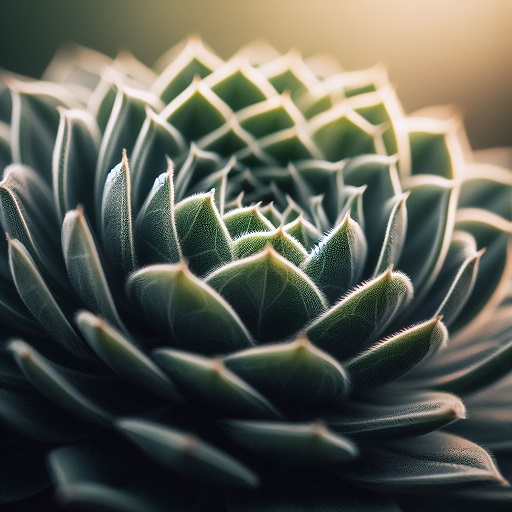
Hen and Chicks are drought-tolerant succulents that prefer full sun to partial shade. They require well-draining soil and should be watered thoroughly but infrequently, allowing the soil to dry out between waterings. They are suitable for outdoor gardens and can tolerate colder temperatures. Hen and Chicks are also popular choices for rock gardens or container plantings.
Ribbon Plant
The Ribbon Plant is a cultivar of the Spider Plant (Chlorophytum comosum). It has long, arching leaves with a unique ribbon-like shape. The leaves are green with white or creamy-yellow variegation, creating an attractive contrast.

The care requirements for Ribbon Plants are similar to those of Spider Plants. They prefer bright, indirect light and average room temperatures. Watering should be done when the top inch of soil is dry, and they can tolerate normal household humidity levels. Ribbon Plants are popular indoor plants, often grown in hanging baskets or as potted specimens.
Each of these plants has its own unique characteristics and care requirements. By understanding their specific needs, you can provide the right conditions for them to thrive and enjoy their beauty in your indoor or outdoor spaces.
Algerian Ivy
As mentioned in plants.ces.ncsu.edu :
Algerian ivy is a climbing evergreen woody vine with large leaves. It is often used as a groundcover. It grows 8-10″ tall but can be high climbing. It may be grown as a ground cover but it needs to be confined as it can be weedy and may require considerable pruning to keep in bounds. Moisture should be fairly consistent to avoid leaf drop.
Algerian Ivy has large, leathery, dark green leaves with prominent veining. The leaves are typically lobed and have a glossy texture. The vines of Algerian Ivy can grow quite long and are known for their vigorous growth. They are commonly used as ground cover or for climbing walls and fences.
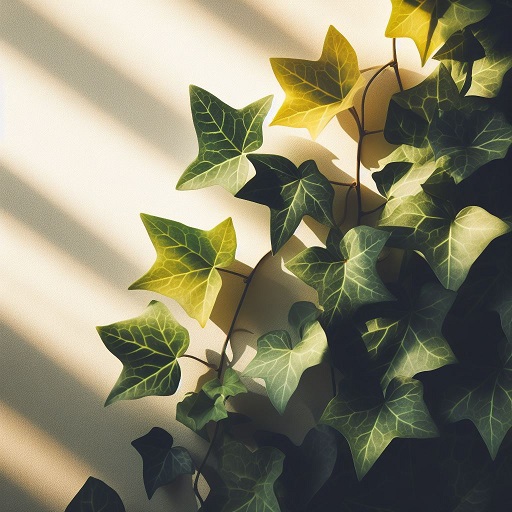
Algerian Ivy prefers partial to full shade and can tolerate a wide range of temperatures. It thrives in moist, well-draining soil and benefits from regular watering. However, it is also relatively drought-tolerant once established. Algerian Ivy can be aggressive in its growth and may require regular pruning to maintain its desired shape.
English Ivy
English Ivy has smaller, lobed leaves that are typically dark green but can also have variegated patterns. The leaves are more delicate and have a slightly waxy texture. English Ivy is a climbing vine that can attach itself to various surfaces using aerial rootlets. It is commonly grown as a decorative plant indoors or outdoors.
As mentioned in The Spruce:
The plant will eventually bear insignificant greenish flowers, but it is grown primarily for its evergreen leaves. In this regard, ivy can be classified as a foliage plant. The best time to plant English ivy is spring. It is a fast, aggressive grower that is considered invasive in many areas. Keep a watchful eye on children and pets because English ivy is toxic to humans and animals.1
English Ivy prefers partial shade to full shade, although it can tolerate some direct sunlight. It grows well in well-draining soil and requires regular watering to keep the soil evenly moist. English Ivy benefits from misting to increase humidity levels, especially when grown indoors. Regular pruning helps control its growth and prevent it from becoming invasive.
Both Algerian Ivy and English Ivy are known for their ability to add a lush, green aesthetic to landscapes, walls, or indoor spaces. They are relatively low-maintenance plants, but it’s important to monitor their growth and manage their vigor to prevent them from overtaking other plants or structures.
Devil’s Ivy Or Pothos
Devil’s Ivy, also known as Pothos, is a popular houseplant with beautiful trailing vines and heart-shaped leaves. Here’s some information about Devil’s Ivy or Pothos

Devil’s Ivy has long, cascading vines with glossy, heart-shaped leaves that can vary in color depending on the cultivar. The most common variety is golden pothos, which has green leaves with yellow or golden variegation. There are also other cultivars with different leaf patterns, such as marble queen (green and white variegation) and neon (bright green leaves).
Care Requirements:
- Light: Devil’s Ivy thrives in bright, indirect light but can tolerate lower light conditions. Avoid direct sunlight, as it can scorch the leaves. It can adapt to various light levels, making it a versatile indoor plant.
- Watering: Pothos prefers slightly moist soil but can tolerate periods of drought. Water the plant thoroughly when the top inch of soil feels dry and allow excess water to drain away. It is better to slightly underwater than overwater, as it is more tolerant of dry conditions.
- Temperature: Pothos plants prefer average room temperatures between 65-85°F (18-29°C). They can tolerate slightly cooler temperatures but are sensitive to cold drafts and frost.
- Soil: Well-draining potting soil is suitable for Devil’s Ivy. It is adaptable and can grow in various soil types but prefers soil that retains some moisture without becoming waterlogged.
- Humidity: Pothos can adapt to normal household humidity levels but appreciates some extra humidity. Misting the leaves or placing the plant on a tray filled with water and pebbles can help increase humidity around the plant.
Devil’s Ivy is not only visually appealing but also helps purify the air by removing toxins. It is considered an excellent air-purifying plant, making it a popular choice for indoor spaces.
Pothos is easy to propagate. You can propagate it through stem cuttings placed in water or directly in soil. Cut a healthy vine just below a leaf node and place it in water or soil until roots develop.
Pothos is a relatively low-maintenance plant. Regularly dust the leaves to keep them clean and free from dust. Prune the vines as needed to control the size and shape of the plant.
Devil’s Ivy or Pothos is a versatile and forgiving plant, making it suitable for both beginner and experienced plant enthusiasts. Its trailing vines make it a great choice for hanging baskets or as a trailing plant on shelves or bookcases.
Rubber Plant
The Rubber Plant, scientifically known as Ficus elastica, is a popular houseplant known for its large, glossy leaves and attractive growth habit. Here’s some information about the Rubber Plant:
Rubber Plants have large, leathery leaves that are typically dark green, but there are also varieties with burgundy or variegated leaves. The leaves are oval or elliptical in shape and have a shiny, waxy texture. The plant can grow into a small tree if given the right conditions and can reach heights of several feet indoors.
Care Requirements:
- Light: Rubber Plants prefer bright, indirect light. They can tolerate lower light conditions but may become leggy with less vibrant growth. Avoid exposing the plant to direct sunlight, as it can scorch the leaves.
- Watering: Allow the top inch or two of the soil to dry out between waterings, then water the plant thoroughly. Rubber Plants prefer slightly moist soil but are susceptible to root rot if overwatered. Reduce watering during the winter months when the plant’s growth slows down.
- Temperature: Rubber Plants thrive in average room temperatures between 60-75°F (15-24°C). They can tolerate slightly cooler temperatures but should be protected from cold drafts and frost.
- Soil: Use a well-draining potting mix or a mix of peat moss, perlite, and sand to ensure proper drainage. The soil should retain some moisture without becoming waterlogged.
- Humidity: Rubber Plants can adapt to normal household humidity levels, but they appreciate some extra humidity. Misting the leaves or using a humidifier can help create a more suitable environment for the plant.
Prune the Rubber Plant as needed to control its size and shape. It is common for the plant to shed its lower leaves as it grows, so removing any yellowed or damaged leaves can help maintain its appearance. Wipe the leaves with a damp cloth to keep them clean and dust-free.
Rubber Plants can be propagated through stem cuttings. Take a cutting with at least two or three leaf nodes and place it in water or moist soil until roots develop.
It’s important to note that the sap of the Rubber Plant is mildly toxic, and ingesting it may cause irritation or allergic reactions in some individuals. Keep the plant out of reach of children and pets.
The Rubber Plant is a stunning and durable houseplant that can add a touch of elegance to any indoor space. With the right care and conditions, it can thrive and become a focal point in your home or office.
Succulents
Succulents are a diverse group of plants that have adapted to arid environments by storing water in their leaves, stems, or roots. They are known for their unique and often fleshy appearance, as well as their ability to tolerate drought conditions. Here’s some general information about succulents:
Succulents come in a wide range of shapes, sizes, and colors. They can be small and compact or have sprawling, trailing growth habits. The leaves of succulents are often thick and fleshy, which allows them to retain water. Some succulents have spiky or textured leaves, while others have smooth, rounded forms. They can also produce colorful flowers, although not all succulents bloom.
Care Requirements:
- Light: Most succulents prefer bright, indirect light. They can tolerate some direct sunlight, but too much can cause sunburn or leaf damage. Some succulents, like Haworthia or Sansevieria, can handle lower light conditions.
- Watering: Succulents are adapted to survive in dry environments, so they generally require less water than other houseplants. Watering requirements vary depending on the type of succulent, the potting mix used, and the environmental conditions. As a general rule, it’s best to allow the soil to dry out completely between watering and then water thoroughly, ensuring that excess water drains away. Overwatering can lead to root rot.
- Soil: Succulents need well-draining soil to prevent waterlogged roots. A cactus or succulent potting mix is recommended, or you can make your own by combining regular potting soil with coarse sand or perlite to improve drainage.
- Temperature: Most succulents prefer temperatures between 60-75°F (15-24°C). They can tolerate a range of temperatures, but extreme cold or heat should be avoided.
- Humidity: Succulents are generally adapted to low humidity environments and can tolerate normal household humidity levels. They may benefit from increased humidity during dry winters or in dry climates.
Succulents are generally low-maintenance plants. Regularly check the plants for signs of pests, such as mealybugs or scale insects, and take appropriate measures to control them. Prune any dead or damaged leaves or stems to maintain the plant’s appearance.
Succulents can be propagated through various methods, including stem cuttings, leaf cuttings, or division. Each method is specific to the type of succulent and may require different techniques.
Succulents are popular for their unique beauty and their ability to thrive in various indoor and outdoor settings. With their striking forms and diverse colors, they make great additions to gardens, terrariums, or as decorative houseplants. Remember to choose succulents that are suited to your specific environment and provide them with the right care to ensure their health and longevity.
Jade Or Money Plant
Jade Plant, also known as Money Plant or Crassula ovata, is a popular succulent that is often associated with good luck and wealth. Here’s some information about the Jade Plant or Money Plant:
The Jade Plant has thick, fleshy, oval-shaped leaves that are glossy and smooth. The leaves are usually a rich jade green color, hence the name. The plant has a compact and bushy growth habit, and with proper care, it can grow up to several feet in height.
Care Requirements:
- Light: Jade Plants thrive in bright, indirect light. They can tolerate some direct sunlight, especially in the morning or evening, but intense, prolonged sunlight can scorch the leaves. If grown indoors, place them near a window that receives bright, indirect light.
- Watering: Jade Plants have typical succulent watering needs. Allow the soil to dry out completely between waterings, and then water thoroughly until water drains from the bottom of the pot. Overwatering can lead to root rot, so it’s better to underwater than overwater. In winter, reduce watering as the plant goes into a dormant period.
- Soil: Use a well-draining soil mix specifically formulated for succulents or cacti. The soil should allow excess water to drain quickly to prevent root rot.
- Temperature: Jade Plants prefer average room temperatures between 65-75°F (18-24°C). They can tolerate slightly cooler temperatures, but avoid placing them near cold drafts or in excessively cold environments.
- Humidity: Jade Plants can tolerate normal household humidity levels. They do not require extra humidity, but dry air may make them more prone to pest infestations.
Jade Plants are relatively low-maintenance. Remove any yellowed or shriveled leaves as they occur. Pruning can be done to maintain the desired shape and encourage bushier growth. Jade Plants are slow-growing and can live for many years with proper care.
Jade Plants are easy to propagate. They can be propagated through stem cuttings or by planting individual leaves. Allow the cuttings or leaves to callus for a few days before planting them in well-draining soil. New roots and shoots will develop over time.
Jade Plants are popular as indoor houseplants and are believed to bring good luck and prosperity. Their compact size and tolerance for a variety of growing conditions make them suitable for homes and offices. With their attractive appearance and easy care requirements, Jade Plants are a great choice for both beginner and experienced succulent enthusiasts.
Asparagus Fern
The Asparagus Fern, scientifically known as Asparagus densiflorus, is a popular houseplant known for its delicate and feathery foliage. Here’s some information about the Asparagus Fern:
The Asparagus Fern has thin, arching stems covered in small, needle-like leaves that resemble fern fronds. The leaves are bright green and have a soft, airy appearance. The plant may produce small white or pinkish flowers, followed by small berries that turn red or black when mature.
Care Requirements:
- Light: Asparagus Ferns prefer bright, indirect light. They can tolerate some direct sunlight, particularly morning sun, but too much intense light can scorch the leaves. Place them near a window with filtered light or provide some shade during the hottest part of the day.
- Watering: Asparagus Ferns prefer slightly moist soil. Water the plant thoroughly when the top inch of soil feels dry, allowing excess water to drain away. Avoid overwatering, as it can lead to root rot. In winter, reduce watering as the plant’s growth slows down.
- Temperature: Asparagus Ferns thrive in average room temperatures between 60-75°F (15-24°C). They can tolerate slightly cooler temperatures but should be protected from cold drafts and frost.
- Humidity: Asparagus Ferns appreciate higher humidity levels. Mist the foliage regularly or place a tray filled with water and pebbles near the plant to increase humidity. They may benefit from being placed in a bathroom or near a humidifier.
- Soil: Use a well-draining potting mix rich in organic matter. A mixture of peat moss, perlite, and sand or regular potting soil with added perlite works well.
Regularly remove any yellow or brown fronds to maintain the plant’s appearance. Asparagus Ferns can be pruned to control their size and shape. Wear gloves when handling the plant, as the stems have small thorns that can be irritating to the skin.
Asparagus Ferns can be propagated through division or by planting the plantlets that form on the mature plant. Gently separate the offsets and plant them in their own containers or directly into the soil.
Asparagus Ferns are versatile plants that can be grown both indoors and outdoors, depending on the climate. They are often used in hanging baskets or as ground cover in gardens. With their delicate foliage and cascading growth habit, Asparagus Ferns add a touch of elegance and greenery to any space.

